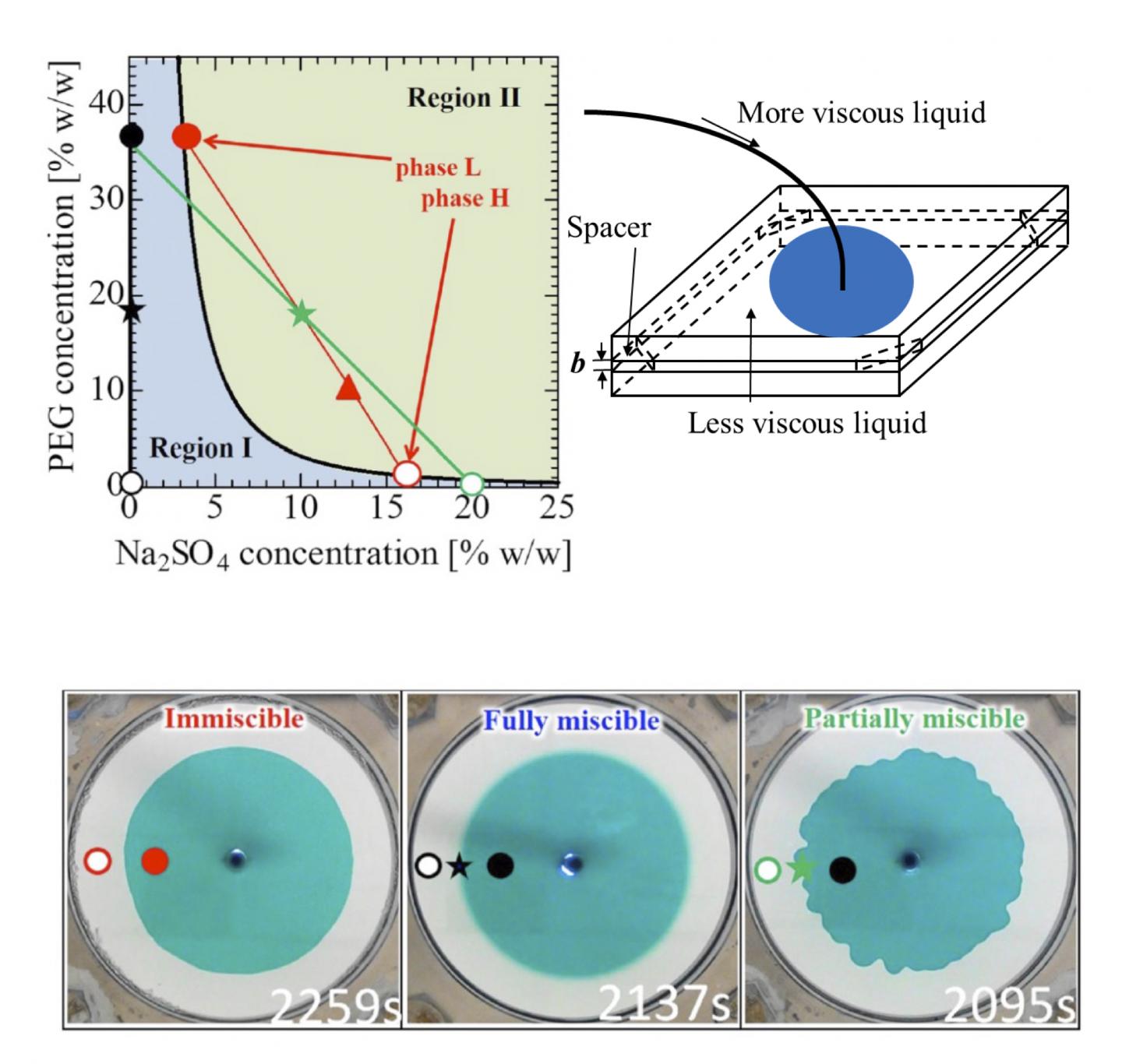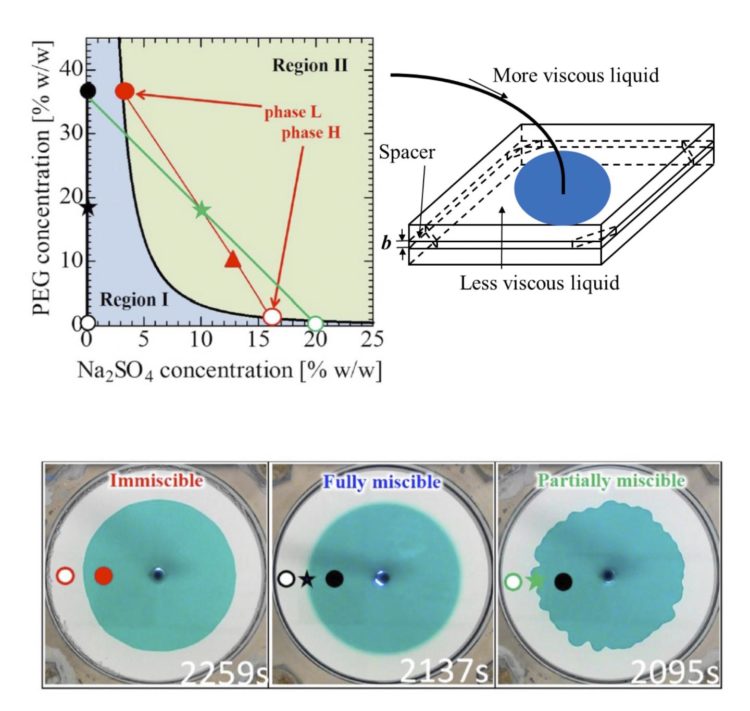Creating a cross-disciplinary discipline of chemical thermodynamics and interfacial fluid dynamics and contributing to higher efficiency of oil recovery and CO2 injection processes

Credit: Yuichiro Nagatsu/ TUAT
The international collaborative team of Tokyo University of Agriculture and Technology (TUAT) (Japan), IIT Ropar (India), Osaka Univ. (Japan) has discovered for the first time in the scientific development that “partially miscibility”, in which the two liquids do not mix completely with finite solubility, is capable of deforming the liquid-liquid interface. This interfacial deformation originates due to the spontaneous motion driven by phase separation between the soluble species, and is a phenomenon that cannot be seen with completely mixed (fully miscible) with infinite solubility or (almost) immiscible with no solubility.
The researchers published their results in Physical Review Fluids on Oct 29th, 2019.
The process of displacing one fluid in a porous medium by injecting another fluid is important in reactions and separation in chemical processes, as well as in enhanced-oil-recovery and CO2 sequestration. In particular, when a less viscous fluid displaces a more viscous fluid, the interface between the two fluids becomes hydrodynamically unstable and deforms in a finger shape. This phenomenon is called “Viscous fingering”, and it has been studied since the 1950s as one fluid dynamics problem. Now, it is widely known that the properties of these two fluids can be traditionally classified according to whether they are fully miscible or immiscible. On the other hand, when a more viscous fluid displaces a less viscous fluid, classically, the interface stably spreads, regardless of whether the two fluids are fully miscible or immiscible.
“It has long been known that two fluids are partially miscible in underground processes with high-pressure conditions, such as oil recovery and CO2 storage, “said Dr. Nagatsu, corresponding author on the paper and an associate professor in the Department of Chemical Engineering at TUAT. “However, the intricate understating of interfacial dynamics in partially miscible systems has not been well-studied. One of reasons is that fluid displacement research has been mainly conducted by fluid mechanics researcher so far, and they missed to find the experimental systems that are partially miscible at room temperature and atmospheric pressure.”
The research team succeeded in changing the miscibility of the system to fully miscible, immiscible, and partially miscible with little change in the viscosities of high-viscosity or low-viscosity liquids at room temperature and atmospheric pressure by using an aqueous two-phase system consisting of polyethylene-glycol (PEG), sodium-sulfate, and water and by changing the salt (sodium-sulfate) concentration (see Fig. (a)). “We found that a new interfacial deformation is observed in the case where the two liquids are partially miscible (see Fig. (c)) when a more-viscous liquid displaces a less-viscous one in a Hele-Shaw cell (Fig. (b)) which is a model mimics flow in porous media. This is very much counter-intuitive because no deformation takes place in such situation when the two fluids are fully miscible or immiscible (Fig. (b)). We showed this interfacial instability originates due to spontaneous flow driven by phase separation between the soluble species”, Nagatsu explains.
“Our result shows that the effect of partial miscibility of liquids on interfacial hydrodynamics is not in the middle of fully miscible and immiscible, but has completely different properties. We emphasize that this will open a new cross-disciplinary research area involving hydrodynamics and chemical thermodynamics. Also, the displacement with partial miscibility in a porous medium takes places in the oil recovery process from the formation and the CO2 injection process into the formation, and thus our finding is expected to contribute to improve the accuracy of the phenomena prediction of those processes, adds Nagatsu.
###
This work was supported by PRESTO-JST (No. 25103004 “Phase Interfaces for Highly Efficient Energy Utilization”) and JSPS Invitation Fellowships for Research in Japan (No. S15063 and No. L19548).
For more information about the Nagatsu laboratory, please visit http://web.
Original publication
Fingering pattern induced by spinodal decomposition in hydrodynamically stable displacement in a partially miscible system
Ryuta X. Suzuki, Yuichiro Nagatsu, Manoranjan Mishra, and Takahiko Ban
Phys. Rev. Fluids, 4, 104005
https:/
About Tokyo University of Agriculture and Technology (TUAT)
TUAT is a distinguished university in Japan dedicated to science and technology. TUAT focuses on agriculture and engineering that form the foundation of industry, and promotes education and research fields that incorporate them. Boasting a history of over 140 years since our founding in 1874, TUAT continues to boldly take on new challenges and steadily promote fields. With high ethics, TUAT fulfills social responsibility in the capacity of transmitting science and technology information towards the construction of a sustainable society where both human beings and nature can thrive in a symbiotic relationship. For more information, please visit http://www.
Contact
Yuichiro Nagatsu, Ph.D.
Associate Professor, Department of Chemical Engineering, TUAT, Japan
[email protected]
Takahiko Ban, Ph.D.
Associate Professor, Graduate School of Engineering Science, Osaka University, Japan
[email protected]
Manoranjan Mishra, Ph.D.
Associate Professor, Department of Mathematics, Indian Institute of Technology Ropar, India
[email protected]
Media Contact
Yutaka Nibu, Ph.D.
[email protected]
81-423-887-550
Related Journal Article
http://dx.





